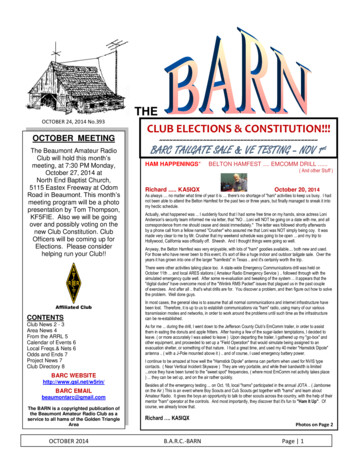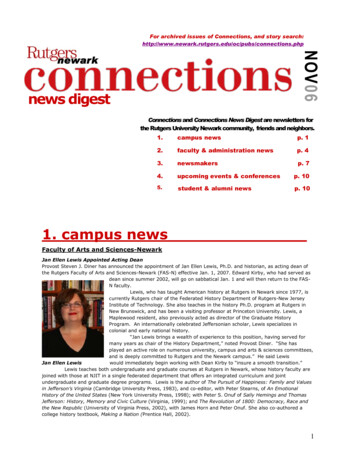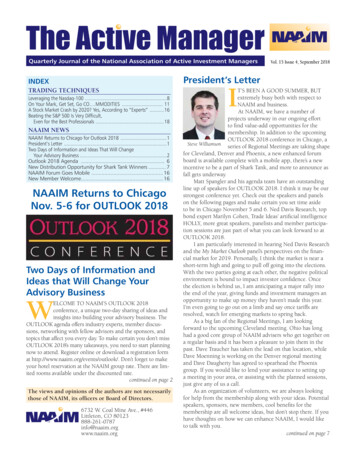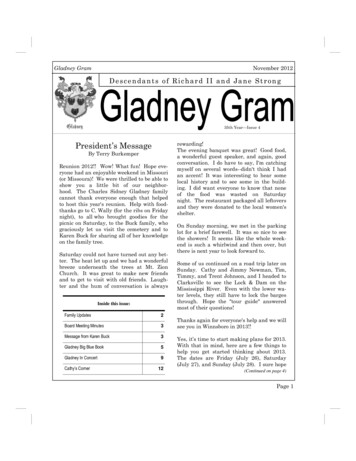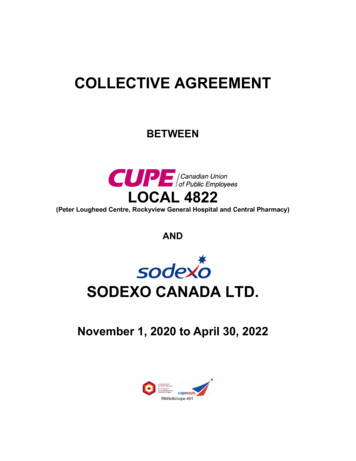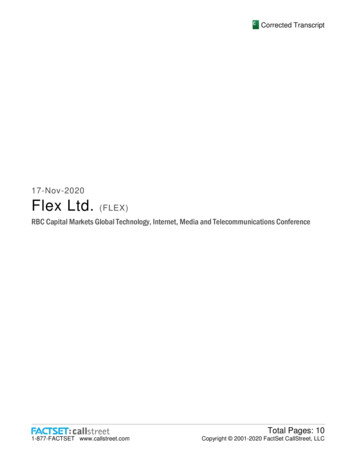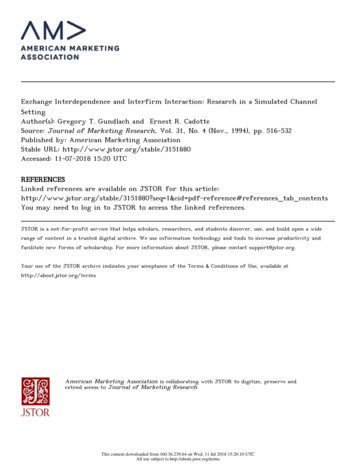
Transcription
Exchange Interdependence and Interfirm Interaction: Research in a Simulated ChannelSettingAuthor(s): Gregory T. Gundlach and Ernest R. CadotteSource: Journal of Marketing Research, Vol. 31, No. 4 (Nov., 1994), pp. 516-532Published by: American Marketing AssociationStable URL: http://www.jstor.org/stable/3151880Accessed: 11-07-2018 15:20 UTCREFERENCESLinked references are available on JSTOR for this article:http://www.jstor.org/stable/3151880?seq 1&cid pdf-reference#references tab contentsYou may need to log in to JSTOR to access the linked references.JSTOR is a not-for-profit service that helps scholars, researchers, and students discover, use, and build upon a widerange of content in a trusted digital archive. We use information technology and tools to increase productivity andfacilitate new forms of scholarship. For more information about JSTOR, please contact support@jstor.org.Your use of the JSTOR archive indicates your acceptance of the Terms & Conditions of Use, available athttp://about.jstor.org/termsAmerican Marketing Association is collaborating with JSTOR to digitize, preserve andextend access to Journal of Marketing ResearchThis content downloaded from 160.36.239.64 on Wed, 11 Jul 2018 15:20:10 UTCAll use subject to http://about.jstor.org/terms
GREGORY T. GUNDLACH and ERNEST R. CADOTTE*The authors employ a simulated market channel to investigate twoproperties of interdependence-magnitude and relative asymmetry.Increasing magnitudes of joint dependence are associated with morefrequent use of noncoercive strategies, less frequent use of coercivestrategies, lower residual conflict, and more favorable evaluations ofpartner performance. These results support the relational exchangeparadigm. Findings for relative asymmetry were not anticipated but areinformative. First, an increasing power advantage did not result in thepredicted greater use of threats and punishments, although demands andnormative statements were more prevalent. Second, one side of the dyaddecreased its use of rewards and the other increased its use of rewards,promises, and information persuasion. As predicted, an increasing poweradvantage (lower relative dependence) is associated with less favorableperformance evaluations of exchange partners and less residual conflict.Exchange Interdependence and InterfirmInteraction: Research in a SimulatedChannel SettingDependence refers to a firm's need to maintain an exchange relationship to achieve desired goals (Frazier 1983)and is considered the obverse of power (Emerson 1962). Inexchange, both participants are, to some degree, dependenton each other. The structure of this reciprocal dependencecharacterizes their interdependence and provides importantimplications for exchange interaction. As characterized byEmerson (1962, p. 34):Reciprocal power provides the basis for studying threefeatures of power relations: first, a power advantage canbe defined as Pab [i.e., Power of A over B], minus Pbawhich can be either positive or negative (a power disadvantage); second, the cohesion of a relationship can bedefined as the average of Dab [i.e., Dependence of A onB] and Dba.; and finally, it opens the door to the studyof balancing operations as structural changes in power-dependence relations which tend to reduce power advantage.Many researchers (i.e., Dwyer, Schurr, and Oh 1987;Mohr and Nevin 1990) have observed that the structure of*Gregory T. Gundlach is an Associate Professor of Marketing, Collegeof Business Administration, University of Notre Dame. Ernest R. Cadotteis a Professor of Marketing, College of Business Administration, University of Tennessee. The authors extend their appreciation to their respectivedepartmental colleagues, anonymous JMR reviewers, and the editor fortheir helpful comments.reciprocal dependence is important to the understanding ofchannel interactions. We hypothesize that this structure affects each partner's disposition toward the other, including(1) exchange behaviors and communications, (2) interpretations of events and outcomes, and (3) residual perceptionsand feelings. If an objective of the firm is to manage itschannel relationships, then it will be helpful to understand,anticipate, and possibly influence what is likely to transpireon each side of the dyad.Few authors have addressed this subject in full. For themost part, their investigations have focused on the power ofone party (i.e., Frazier, Gill, and Kale 1989; Frazier andSummers 1984; Gaski and Nevin 1985; Kale 1986). Someinvestigators have measured perceptions of relative dependence (i.e., Anderson, Lodish, and Weitz 1987; Andersonand Narus 1990; Anderson and Weitz 1989; Buchanan1992), and others have statistically controlled for a partner'sdependence or power (i.e., Frazier and Rody 1991; Frazierand Summers 1986). Although these studies are important,they do not separately measure the dependence or power ofboth parties, nor do they explore how they combine to affectother channel phenomena.Our objective is to explore more fully the concept of interdependence. Following Emerson (1962), we offer a conceptualization incorporating the properties of magnitude(i.e., cohesion) and relative asymmetry (i.e., power advantage). Hypotheses relating these dimensions to interfirm influence, conflict, and performance are tested within a simuJournal of Marketing Research516Vol. XXXI (November 1994), 516-532This content downloaded from 160.36.239.64 on Wed, 11 Jul 2018 15:20:10 UTCAll use subject to http://about.jstor.org/terms
517Exchange Interdependence and Interfirm Interactional gain and autonomy. Together, these characteristics complicate coordination of exchange activities.research.In contrast, high-magnitude relationships depict involvedor established exchange associations. In these relationships,HYPOTHESESjoint dependence mitigates or, at minimum, reduces tensionsInterdependence has been explored and defined conceptuarising from increased functional interdependence. Eachally within a variety of social science disciplines. Pfefferandparty'spossession of power, coupled with benefits obtainedSalancik (1978, p. 40) state, "Interdependence exists fromwhenthe relationship, fosters an atmosphere of cooperationever one actor does not entirely control all of the conditions(Dwyer, Schurr, and Oh 1987). Implicit or explicit pledgesnecessary for the achievement of an action or for obtainingof relational continuity (Anderson and Weitz 1989), jointthe outcome desired from the action." Similarly, Tedeschi,planning (Frazier and Rody 1991), and solidarity (MacneilSchlenker, and Bonoma (1973, p. 234) observe that interde1980)-hallmarks of these associations-contribute to bilatpendence represents "the degree to which one actor'seralbeand programmed interaction.haviors, acts or other goals are dependent for their occurInterfirm influence. In low-magnitude relationships, interrence or change on the behaviors, actions or goals ofactionsone orcan be quite competitive, with participants engaginga set of other actors." In channels research, Cadotte andin tough bargaining and employing coercive forms of influStem (1979, p. 133) suggest that "interdependence meansence to obtain desired terms. Coercive influence strategiesthat two or more organizations must take each other into ac- are defined as mechanisms for gaining target compliancecount if they are to accomplish their goals." Etgar and Va- that reference or mediate negative consequences for nonlated exchange environment. We conclude with a discussionof results and implications and suggestions for furtherlency (1983, p. 87) believe that "channel interdependence compliance. Given the lack of substantive dependence, therefers to the extent to which distributors and suppliers arecommitted to mutual exchanges."These definitions suggest that firms become interdependent as a result of engaging in economic exchange to obtainresources outside their control but necessary to their goals.The degree of interdependence affects each party's motivation, behaviors, and perceptions in the exchange.A limitation of this interpretation and prior conceptualizations is that they are necessarily incomplete. As such,they constrain our theoretical perspective on how interdependence affects exchange interaction. For example, to observe simply that two parties are dependent on each otheroverlooks their balance of power and the relative freedom ofeach to act in its own self-interest. Similarly, to observe thatone party has a power advantage fails to recognize their jointdependence and its constraints. We propose that interdependence be further defined to include the structure of dependence existing within an exchange relationship. This struc-ture can be characterized by two dimensions-magnitudeand relative asymmetry.Magnitude of InterdependenceMagnitude is defined as the sum of the dependence in anexchange and embraces Emerson's (1962) notion of cohesion. Conceptually, magnitude characterizes the amount of"attention" concerning policies and issues given to a relationship by exchange partners (Mohr and Nevin 1990).Dwyer, Schurr, and Oh's (1987) four subprocesses of relationship development-awareness, exploration, expansion,and commitment-characterize increasing magnitudes ofinterdependence.In a transactional sense, minor relationships (i.e., lowmagnitude) warrant neither the time, effort, nor opportunitycost for extensive interaction (Anderson and Weitz 1989).Often these relationships are seen as a series of discretetransactions with roles reduced to simply those of buyer andseller and the benefit of an exchange assessed on the basisof each transaction (Kaufmann and Stem 1992). Terms ofexchange are explicitly specified for each transaction withincentives to cooperate countered by the desire for individu-use of coercive strategies is less apt to result in costly repercussions, and therefore their greater frequency can be expected (Roering 1977). The frequency of noncoercive strategies, such as rewards and information exchange, is also likely to be lower. Noncoercive influence strategies are definedas mechanisms that reference or mediate positive consequences for compliance (cf., Hunt and Nevin 1974). Thesestrategies are not without cost. Without a quid pro quo or theprospect of a long-term pay off, the cost of these strategiesmay exceed their benefits.In high-magnitude relationships, noncoercive strategieswill be favored over coercive forms of influence because oftheir less volatile nature (Raven and Kruglanski 1970).These strategies contribute to the relationship, strengtheningeach firm's identification with the other, and increasingagreement (French and Raven 1959). As Frazier and Rody(1991, p. 655) suggest, '"The fact that most noncoercivestrategies center on the 'inherent desirability' of performingcertain actions . lead[s] to greater conceptual agreementbetween firms." Over time, the use of noncoercive strategiesresults in each firm's programs, policies, and behaviors becoming more predictable and aimed at conducting the relationship in a coordinated rather than autonomous fashion(Stem and Reve 1980).This perspective is supported indirectly by Gaski andNevin (1985) and Anderson, Lodish, and Weitz (1987), whoreport cooperative and integrative behavior in contractual relationships possessing moderate to high joint dependence.Frazier and Rody's (1991) research in an industrial productschannel indicates that noncoercive strategies increase andcoercive strategies decrease as the power of manufacturersand distributors increases. Similarly, Boyle and colleagues(1992) find that the use of coercion diminishes as relationalism increases in an exchange.We offer the following hypotheses:Hi: A's use of noncoercive strategies toward B will be positively related to the magnitude of their interdependence.H2: A's use of coercive strategies toward B will be negatively related to the magnitude of their interdependence.This content downloaded from 160.36.239.64 on Wed, 11 Jul 2018 15:20:10 UTCAll use subject to http://about.jstor.org/terms
JOURNAL OF MARKETING RESEARCH, NOVEMBER 1994518Conflict. Consideration of the relationship between magnitude and conflict suggests a "conflict paradox." At higherlevels of joint dependence, potential conflict increases asopportunities for interference in each party's goal attainmentincrease (Cadotte and Stem 1979). Potential or latent conflict, however, need not lead to manifest and conflict aftermath. As exchange relationships evolve through their developmental stages and, presumably, higher levels of joint dependence, conflict may actually decrease.In the early stages, the potential for conflict stems largelyfrom differences in language and expectations and a lack offamiliarity with each other's operating policies and procedures. Standards often lack clarity, with each party reactingtentatively toward the other. To evolve, however, and prior tomaking substantial commitments, fundamental issues (e.g.,incompatible goals, unrealistic demands) must be resolved.When problems persist, termination of the exchange is likely.Relationships grow to the extent that one or both partiesadapt to their fundamental differences. Adaptive behaviorsfacilitate the convergence of perspectives and goals. Recognition of each other's dependence, and hence the power ofthe other, fosters cooperation, thereby enhancing benefitsand future commitment. Together, these factors help lowerperceived conflict. Of course, economic factors, executionerrors, and other pressures occasionally strain any relationship. However, incentives and mechanisms for cooperatively resolving conflict are greater and more available in relationships of high magnitude than in those of low magnitude.In summary, potential conflict increases as the magnitudeof interdependence grows. However, incentives for cooperative interaction and normalization of the exchange relationship in high-magnitude associations temper manifest conflict in favor of adaptive problem reso
Magnitude of Interdependence Magnitude is defined as the sum of the dependence in an exchange and embraces Emerson's (1962) notion of cohe- sion. Conceptually, magnitude characterizes the amount of "attention" concerning policies and issues given to a rela- tionship by

